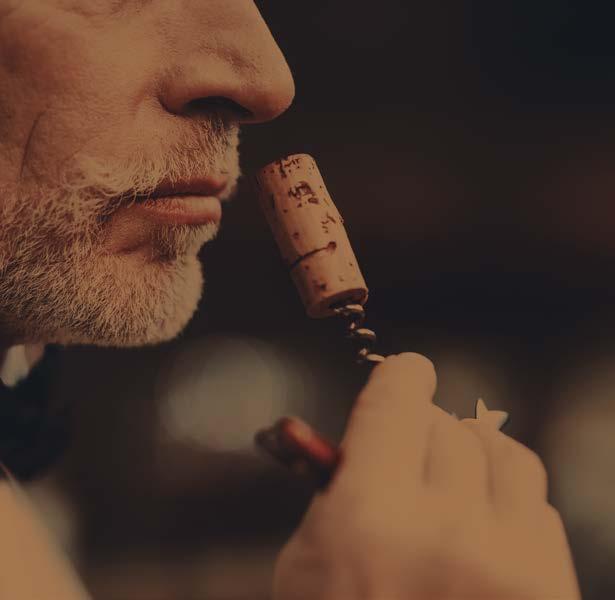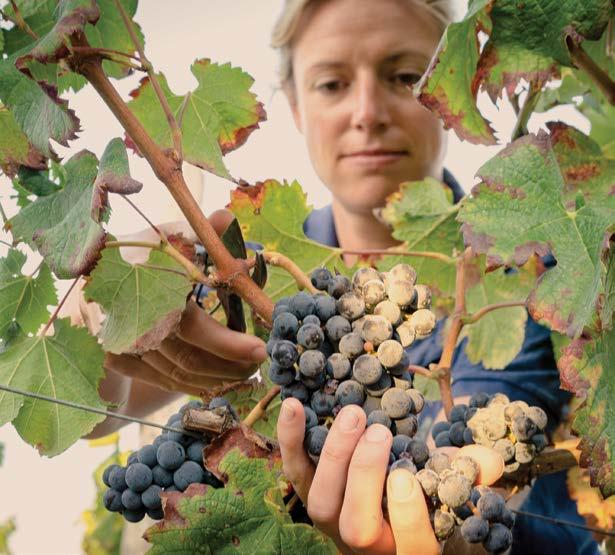









P14
JACQUES CHARLET
LA VAUXONNE, AOP
BEAUJOLAIS-VILLAGES, JACQUES CHARLET, 2020, LOT 2531, P16

CHÂTEAU PIQUE-SÈGUE
CHÂTEAU PIQUE-SÈGUE, AOC BERGERAC, 2019, LOT 2534, P19
I always enjoy the tasting for the Cellar Offering featuring Beaujolais, Bergerac & Bordeaux. The Bordeaux region in south-west France is probably the most famous wine-growing region, producing some of the world’s finest wines as well as fair priced wines for everyday drinking. Bordeaux is also where my wine career started and where I studied oenology. In this Cellar Offering you will find diverse red, white, rosé and sweet wines from different appellations across the Bordeaux region. Bergerac, which lies to the east and further from the influence of the Atlantic Ocean, has its own personality. These two regions contrast with Beaujolais, a small region located south of Burgundy on the eastern side of France. Its granitic soils are perfect for the Gamay grape, producing vibrant fruity red wines.
JANE MASTERS MW, OPIMIAN’S MASTER OF WINE
Every wine offered by Opimian is tasted and selected for its deliciousness and value by our consultant Master of Wine, Jane Masters. Jane has an in-depth knowledge of the world of wine. Her aim is to share her experience and love of wine with members in an easy and informal manner. She is one of 408 Masters of Wine worldwide and was elected Chairman of the Institute of Masters of Wine 2016-2018 by her peers.


P25


ELISABETH COGNAC
ELISABETH FINE COGNAC MIXED CASE, LOT 2541, P25

P26
BORDEAUX WHITES
PETITE MARINE SAUVIGNON BLANC, AOC BORDEAUX, THE DARRIET FAMILY, 2020, LOT 2558, P28

P36
BORDEAUX ROSÉS
CHÂTEAU HAUT MAGINET, AOC BORDEAUX ROSÉ, VIGNOBLES JOLIVET, 2020, LOT 2548, P37

P34
BORDEAUX SWEET WHITES
CHÂTEAU FONTEBRIDE, AOC SAUTERNES, SCE CHÂTEAU HAUTBERGERON, 2019 , LOT 2547, P35

P38
BORDEAUX SUPÉRIEUR REDS
CHÂTEAU DU PIN, AOC BORDEAUX, 2019, LOT, 2550, P40

P44
THEIR MOST POPULAR OPIMIAN WINES
DELIVERY WILL BE FALL 2021
cover —Charlotte Krajewski, the winemaker at Château Séraphine in Pomerol and Clos Cantenac in Saint- Émilion surveys the situation prior to harvest..
BORDEAUX LEFT BANK
CHÂTEAU CAMINO SALVA, AOC HAUT-MÉDOC, 2016, LOT 2569, P48

P52
BORDEAUX RIGHT BANK
PETIT CANTENAC, AOC SAINTÉMILION GRAND CRU, 2019, LOTS 2592-94, P57
Michael Lutzmann and Greg Rinehart, Opimian Co-Managing Directors
Bordeaux, Beaujolais & Bergerac. What do they have in common (other than starting with 'B' )? They are all in France. They are all known for their wine excellence. Most importantly, they are the most popular Cellar with you, the Members, year after year as far back as we can see.
What don't they have in common? While the wines of Bordeaux and Bergerac share some similarities, the wines of Beaujolais are completely different. Beaujolais is often referred to as the smallest house in the fanciest neighbourhood, as Burgundy borders it to the north. As one might expect, it is also small, at around 50 kilometres in length and 15 kilometres wide, with the 10 Beaujolais Crus (Morgon, Fleurie, etc.) located on the granite soils to the north and the Beaujolais Villages situated in clay soils to the south.
This trio of regions is one of the few that we have kept together from previous years. That being said, the pages that follow are unlike those you've seen in the past. Part for education, part for simple clarity, you'll find it organized geographically by appellation (AOC) rather than by supplier as in past years. For example, the predominantly Cabernet Sauvignon-forward wines gradually transition to the Merlot based wines as you turn the pages and journey from the left bank to the right bank AOCs. You won't want to miss the introductions from Jane Masters MW. Through them, you'll learn all about what makes each region unique and worth discovering.
Our Cellar Up! feature has been so popular we're bringing you another way to enhance your collection. Have a look at the Instant Cellar on page 32. We've created a package for you to take the guesswork out of what to buy to have a professionally curated, Bordeaux cellar with one click.
We will also take a small side trip to Cognac and Armagnac for world-class brandy and add a new stop in Norway this year for a Canadian first. We're bringing you a triad of products that cleaned up at the awards ceremony at last year’s Global Spirits Masters in London.
We wanted to bring your attention to some new voices to Opimian in this Cellar. Look for an article from Konrad Ejbich, a well-known Canadian wine journalist. He'll take you to Beaujolais. In addition, Jacky Blisson MW, one of only a handful of Canadian Masters of Wine, informs us of the new winemaking rules that have just been introduced in Bordeaux. Enjoy the spring weather and travel virtually to France with us. Don't forget your wine glass.
Michael & Greg
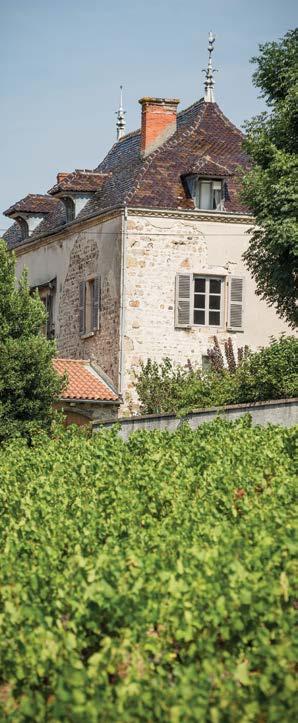

GREG’S PICKS
GREG & MICHAEL’S PICKS FOR THIS CELLAR OFFERING

CHÂTEAU DE DURETTE, CUVÉE LES GIMARETS, AOP MOULIN À VENT, 2019 LOT 2521, P11

OHD NORWEGIAN WOOD BIRCH VODKA LOT 2537, P20

CHÂTEAU PIQUESÈGUE, AOC BERGERAC, ROSÉ, 2020, 2017, LOT 2535, P19

MICHAEL’S PICKS

CHÂTEAU SÉRAPHINE, AOC POMEROL, 2019 (WOOD CASES), LOT 2599, P59

CÔTE DU PY, AOP MORGON, VIEILLES VIGNES, JACQUES CHARLET, 2018, LOT 2530, P16

CHÂTEAU DAUPHINÉ RONDILLON, CUVÉE D'EXCEPTION, AOC LOUPIAC, VIGNOBLES J. DARRIET, 2009, LOT 2560, P34
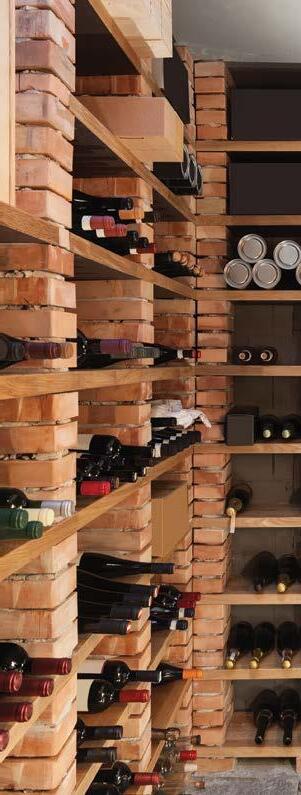
MASTER PIECE
Jane Masters MW is Opimian’s Master of Wine
I don’t have a fancy looking walk-in wine cellar or even a dedicated wine fridge. My wines aren’t all perfectly organized and catalogued. In fact, I must admit that I don’t even have an accurate up-to-date list of all my wine purchases. I do have a spreadsheet, but I don’t always remember to update it!
I never quite know what wines I have. To complicate matters further, I have wines squirreled away in various locations in both France and the UK, depending on when and where I bought them and will want to drink them.
I don’t usually buy wines for financial return, although I do have a few investment-grade wines for which there is a market and could be sold. These are wines that are not ready for drinking now. To avoid temptation and just in case I do decide to sell them, they are stored in an external, climatized bonded wine warehouse. But generally, I buy wines for me, for drinking and for sharing.
What I love about having a wine cellar is having wines on hand for whatever the mood or occasion. The spontaneity of friends dropping by (remember those days?) and opening a bottle to share, or that Friday evening winding down feeling, or simply celebrating the sun shining… If a particular food is in season, I love digging out the perfect bottle to go with it. Although I have to admit that in my house we often do it the other way around – decide what we are going to eat based on the wine we fancy drinking!
In my daily work I come across bottles that blow me away. Over the years, I have had a few surprises tasting wine, some good and some bad. The nice surprises have been inexpensive wines made by the winemaker to be sold and drunk relatively young, but whose concentration and richness suggested more potential and were still showing well after 20 years. Some old Chilean Cabernets and Crozes-Hermitage come to mind.


DON'T MISS OUR BORDEAUX INSTANT CELLAR COLLECTION ON PAGE 32.
CHÂTEAU LES TUILERIES, AOC BORDEAUX, ROUGE, 2018, LOT 2584, P40


CHÂTEAU PIQUESÈGUE, AOC MONTRAVEL, 2020, LOT 2536, P19
CHÂTEAU DE ROUQUETTE, AOC CADILLAC CÔTES DE BORDEAUX, VIGNOBLES J. DARRIET, 2018, LOT 2564, P41


MADAME DE BEAUCAILLOU, AOC HAUT-MÉDOC, FAMILLE EUGÈNE BORIE, 2018, LOT 2553, P50
There have been wines that I have bought and tucked away and then forgotten about. When lockdown first happened last year, I dug out a few of these old treasures, only to find that I had left them a bit too long in some cases! As a result, I was spurred on to drink more of my older wines rather than wait for the “right” special occasion. This past year I have been enjoying some deliciously mature bottles. Wines which, even if I wanted and could afford to, I would not be able to find in a wine shop now. All wines have a life and optimum drinking period. Everyone’s taste preferences are different, and this includes a preference for younger or older wine styles. Many wines are made to be drunk young and will not improve. For those that are made to be aged, at their peak these wines have an extra dimension in terms of taste. But go too far and they “dry out”, becoming thin and dull. Having a case of wine in the cellar allows you to try a wine at different points in time and it is fascinating to see how it develops over the years.
Of course, it’s not always easy having a wine cellar full of delicious wines. There is often the temptation when a wine is drinking well that one bottle is simply not enough. If the bottles are close at hand, before you know it the case is down to one last bottle and the dilemma then is when to open that final one.

Located at the southern end of the Burgundy region, Beaujolais specializes in the Gamay grape. This is because of the granitic soils in the region, whereas much of Burgundy is limestonebased. Within the region are ten individual “Crus” – situated on a series of gentle granite hills that start just south of Mâcon. Beaujolais-Villages wines are made in 38 villages that encircle the ten Beaujolais Crus. Southwards, around Villefranche-surSaône and towards Lyon, the landscape is flatter. This is where the majority of Beaujolais wines are made. Pockets with higher amounts of limestone in the soil are more suitable for growing Chardonnay, which is used to make white and sparkling wines.
PRODUCERS FOR THIS CELLAR


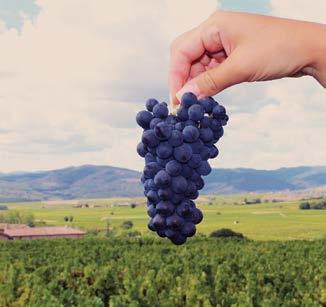
2520

DOMAINE DIT BARRON, AOP BROUILLY, GILLES AUJOGUES, 2020
2527
Gilles Aujogues and his wife Muriel are based in Brouilly, the most southern of the Beaujolais Crus. The winery at Cercie looks across to the slopes of Mont Brouilly and its chapel built to put vineyards under the protection of the Virgin Mary. Vibrant in colour, Domaine dit Barron 2020 has sweet berry fruits, ripe blackberry, and mulberry with some fresh green herb aromas. It is supple and smooth with a nice bitter cherry finish. Gilles regularly wins medals for his wines and this is no exception: awarded Gold Medal at the Concours International du Gamay.
DOMAINE DE LA MAISON ROSE, AOP BROUILLY, JACQUES CHARLET, 2020
$ 36.00 $ 216.00
This has aromas of red apples and ripe cherries. Initially soft on the palate, it becomes quite astringent with some chewy tannins and a grippy finish. Red fruit flavours dominate followed by lingering bitter chocolate adding length. Grapes came from plots between 70 and 80 years old planted on deep sandy soils at the bottom of Mont Brouilly.

FIND MORE WINES FROM THIS PRODUCER ON PAGE 14.

DID YOU KNOW?
by Konrad Ejbich
Beaujolais is one of the most widely consumed red wines in the world. Perhaps that’s because it’s unabashedly simple, highly refreshing, delicious and completely food friendly.
Most wines require some thought before being paired with foods. Beaujolais says “bring it on.” The unique winemaking process (carbonic maceration, look it up) yields wines of immense freshness, bursting with berry aromas and flavours, round in the mouth, full bodied; but without any heavy tannins to tire the palate.
Beaujolais and its robust neighbour, Beaujolais-Villages, bring joy to the palate and to the dinner table, rather than hushed tones discussing minerality to a backdrop of Mahler. Beaujolais is a wine to chill lightly, pour freely at holiday gatherings, buffets and banquets, or just to enjoy with free-spirited friends.
From the earliest days of Roman expansion, armies of soldiers plowed roads through France as they moved north to Gaul. They ordered the clearing of land and the planting of olives for oil, barley for bread and vineyards for wine.
Just north of Lyon, in the district called Beaujolais, only the Gamay grape flourished, and it survives to this day.
The southern half of the region is gently rolling, with chalky and marly clay river deposits that yield wines of lush aromas, and charming fruit to be consumed within a year or two.
The northern half becomes much hillier, with distinct pockets of porphyry, granite, and manganese: these are the terroirs where ten special Beaujolais Crus offer more depth, complexity and a bit of longevity.
Just a few kilometres south of Mâcon, the southernmost white Chardonnay appellations of Pouilly-Fuissé and Saint-Véran give way to the red Gamay grape of Beaujolais and the fullest crus: Saint-Amour, Juliénas, Chenas, Moulin-àVent, Fleurie, Chiroubles, Morgon, Regnié, Côte de Brouilly and Brouilly.


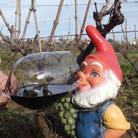
Each has its own idiosyncrasies: some are bolder (Moulin-à-Vent, Chenas, Morgon), some fruitier (Brouilly, Côte de Brouilly), some more velvety (Fleurie, Juliénas, Saint-Amour), and others perfumed and delicate (Chiroubles, Regnié). And each is wonderful in its own right.
Beaujolais Nouveau (a.k.a. Primeur) is the annual first taste of the vintage. It’s something to be truly excited about...for, maybe, fifteen minutes. Nouveau is like the introductory chapter to a good book, attention-grabbing and engaging, but what follows is bound to be more interesting and fulfilling. Once you’ve had a bottle of Nouveau (best consumed in the six weeks before New Year’s Eve), it’s time to move on to the more serious Beaujolais of the region.
Beaujolais isn’t a great, big wine; it’s a great, little wine.
Konrad Ejbich is a writer, broadcaster, teacher and taste-meister. His articles have appeared in Wine Spectator, Decanter, Meininger's Wine Business International and numerous Canadian publications. At the beginning of his career, he won the Nouveau race to Canada three times.
2521 CHÂTEAU DE DURETTE, CUVÉE LES GIMARETS, AOP MOULIN À VENT, 2019
Gamay
$ 40.00 $ 240.00

A new find and one of my favorites in the Beaujolais line up. It has intense aromas with red fruits, floral notes and sweet blackberries. It is supple and smooth with more mixed sweet fruit flavours giving lots of appeal – which are perfectly balanced with a touch of bitterness. Château de Durette is a relatively new property established in 2007. Cuvée Les Gimarets is produced from a 1.5-hectare plot of 45-year-old vines on pink granite soils with veins of manganese minerals.
2528 LES PHILIBONS, AOP MOULIN À VENT, CÔTE DE GRANIT, JACQUES CHARLET, 2018
Gamay
$ 35.00 $ 210.00
A spicy mellow wine with aromas of black fruits, black cherries, blackberries and vanilla. It also has some floral notes and a touch of graphite. More mellow sweet fruits and vanilla dance on the palate and lead to lingering spicy, woody flavours. Winemaker Frédéric Maignet matured the wine on lees after fermentation with a part aged in oak barrels. Moulin-à-vent is the most northern of the ten Beaujolais Crus and produces some of the most concentrated structured wines.

THESE WINES ARE FOOD FRIENDLY AND GREAT FOR SIPPING ON THEIR OWN. CHOOSE BOTH!

Bernard Perrin was born in the little medieval hilltop village of Ternand, which was built in the 12th century under the ownership of the Archbishop of Lyon. Bernard can trace his Perrin family history as owners of Domaine de Milhomme to the 16th century: today, he and his nephew Manu continue the family tradition.

2522
DOMAINE DE MILHOMME, CUVÉE LE MÛRIER, AOP BEAUJOLAIS, 2020 Gamay
26.00
156.00
75-year-old vines in the Le Mûrier vineyard are planted on fine granite soils close to Ternand. The 2020 has aromas of rose petal, violets and red fruits. It is supple and smooth with a fine silky texture and has fresh acidity with sour red cherry flavours.
Pan-seared ahi tuna with soy-ginger sauce

2523

DOMAINE DE MILHOMME, VIGNE CENTENAIRE, AOP BEAUJOLAIS, 2019
$ 29.00 $ 174.00
A more savoury wine, produced from 130-year-old vines: it is bright in colour with fresh green herbal aromas with earth and wet stone. Some red fruits emerge on the palate, but overall it is savoury in nature with some grip and a sour blackberry, mineral and bitter prune finish.

Thomas Broyer is the third generation to run the family estate, Domaine de Sancy, based in Juliénas. Thomas farms 9.5 hectares of vines, and like many small growers in Beaujolais has vines in several Appellations. His wines are fresh and fruity, made in a traditional way that allows the expression of each terroir. Discover the difference the terroir makes in three wines from the 2020 vintage: a year when a mild winter, followed by warm spring weather led to early bud break in the vineyard; hot summer temperatures led to full grape maturity with harvest in early September.
2524
DOMAINE SANCY CRUS DU BEAUJOLAIS MIXED CASE

DOMAINE SANCY, AOP CHÉNAS, THOMAS BROYER, 2020
DOMAINE SANCY, AOP JULIÉNAS, THOMAS BROYER, 2020


DOMAINE SANCY, AOP SAINT-AMOUR, THOMAS BROYER, 2020
Subtle aromas with red cherries and other berries with green leaves: think aromas of early morning hours in a dewy forest. It is supple with bitter red berry finish. Vines are more than 90 years old on a south-facing plateau.
The 2020 Juliénas is a bit more expressive with delicious floral, red berries and biscuity notes. It is smooth, developing a firm acidity on the palate with blackberry flavours and a crunchy cranberry finish.
calamari with passion fruit dipping
Coming from the most northern and smallest of the Beaujolais Crus, Domaine Sancy SaintAmour was the least expressive at the time of tasting. A hint of apple and blackberry on the nose precede a supple round palate. It is quite rich with nice floral violet notes showing through and should open with time.
2021-2023, M8
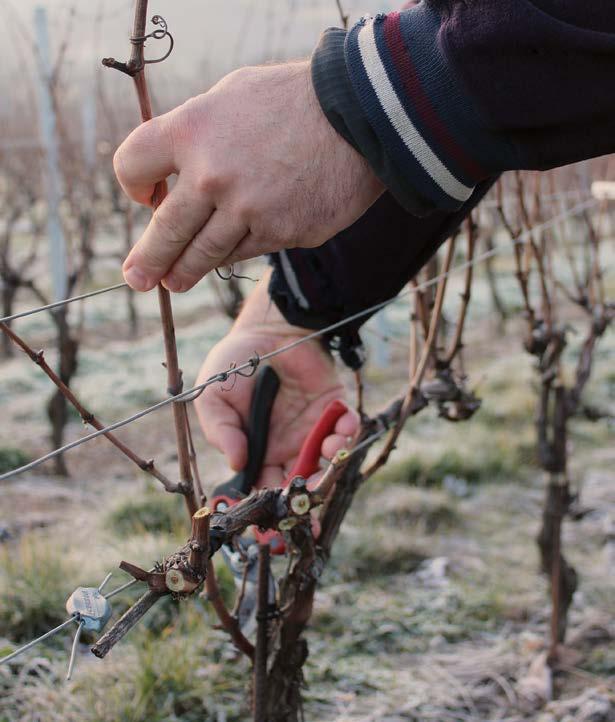
Jacques Charlet is a small négociant and land owner. The company has several estates in different Crus in the Beaujolais region. It also buys in grapes to vinify with wines made by Frédéric Maignet and purchases selected wines from local estates.

A tight and structured Beaujolais, it is medium bodied with red cherry and savoury notes. One of the rare “clos” in Beaujolais, Le Clos des Poulettes is 1.5 hectares at the entrance to the village of Juliénas on stony alluvial soils.


2531 LA VAUXONNE, AOP BEAUJOLAISVILLAGES, JACQUES CHARLET, 2020

Whilst a little subdued on the nose, this 2018 Côte du Py has lots of succulent fruits, blackberries and cherries on the palate. It has a grainy texture with a long bitter cherry and dark-chocolate finish. Côte du Py is a prime spot within the Morgon Cru. Grapes were grown on silty clay soils rich in magnesium minerals over deep schist.
$ 27.00 $ 162.00
Beaujolais-Villages wines are made in 38 villages that encircle the ten Beaujolais Crus situated at an average altitude of 350 metres. This is a supple smooth wine with aromas of strawberries, red fruits and some bitter cherry flavours on the finish. Whole clusters of grapes were fermented and aged on fine lees.
Coq au vin
Cinnamon-roasted butternut squash


2532
L'OR DES PIERRES, AOP
BEAUJOLAIS, ROUGE, JACQUES CHARLET, 2020
Gamay
$ 26.00 $ 156.00
A medium-bodied Beaujolais with strawberries, red cherry and apple flavours with a savoury finish.
2021-2023, M8 D9
Strawberries, confection 16°C
Red cherry, apple 13%
Saucissons à la Navarraise (sausages with sweet peppers and wine)

2533
L'OR DES PIERRES, AOP
BEAUJOLAIS, BLANC, JACQUES CHARLET, 2020
Chardonnay
$ 31.00 $ 186.00
Most of the soils in Beaujolais are granitic; however, there are some pockets of limestone more suited to Chardonnay and used to produce a small amount of white wine – only about 2% of the region’s production. The 2020 is a refreshing wine with intense aromas of apples, pears and spring blossoms.
2021-2022, M8 D9
Apples, pears, blossom 6°C
Refreshing, [D] 13%
Baked mussels with garlic butter

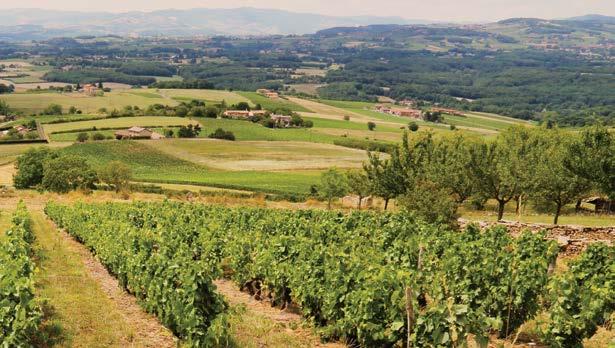
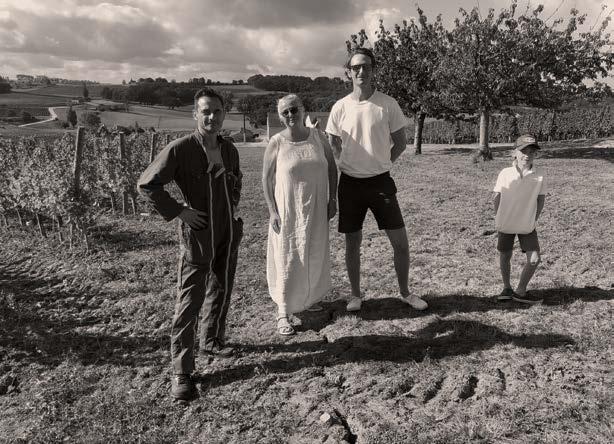
Bergerac, in the Dordogne department in southwest France, neighbours the Bordeaux region and has an equally long history of making wines.
An estate with 700 years of history, Château Pique-Sègue was first noticed in the 14th century by the Archbishop of Bordeaux. By the 19th century, it was recorded as “one of the best wine-growing holdings of the area” in Cocks & Féret’s reference work. After purchasing the estate in the 1990s, Philip and Marianne Mallard have worked tirelessly to restore it to its former glory farming 70 hectares of vineyard and breeding Limousin cattle.
2534 CHÂTEAU PIQUE-SÈGUE, AOC BERGERAC, 2019
Merlot, Cabernet Sauvignon
$ 27.00 $ 162.00
Some floral aromas of lavender combine with green leafy character and precede a supple smooth palate. It is medium bodied with good mid-palate weight and emerging bitter dark fruit flavours. This wine builds in the mouth having grip and a savoury Marmite and slightly austere finish. Produced from a blend of 80% Merlot with 20% Cabernet, it has some potential for cellaring.

dark
2535 CHÂTEAU PIQUE-SÈGUE, AOC BERGERAC, ROSÉ, 2020
Cabernet Sauvignon

$ 27.00 $ 162.00
A rosé produced from Cabernet Sauvignon, it is very pale in colour and aromatic with red fruits, and floral notes of rose. Mouthwatering on the palate, it has a juicy acidity with flavours of red cherries and watermelon.
2536
CHÂTEAU PIQUE-SÈGUE, AOC MONTRAVEL, 2020
Sauvignon Blanc, Sauvignon Gris

$ 27.00 $ 162.00
I just love this wine: it is floral and intense with aromas of white peaches and orange blossom. On the palate it is immediately supple and round developing a firm crisp acidity and finishing with flavours of mandarin and grapefruit. After harvest, Sauvignon grapes were left to macerate for 12 hours before gentle pressing. It was fermented at low temperature, then matured on fine lees.
Char-grilled squid

RARE FINDS TO ENHANCE YOUR CELLAR
Pre-prohibition, in the early 20th century, Norway had a long tradition of craft distillation. The Oslo Handicraft Distillery (OHD) was founded in 2015 by Martin Krajewski (known to many Opimians as owner-producer of Clos Cantenac in Saint-Émilion), Marius Vestnes and Marcin Miller to revive the tradition. It makes handcrafted spirits from potatoes and captures the taste of Norway using wild plants that grow in the mountains, meadows and forests – many of which were revered for their medicinal properties in times gone by.

Herbal pine and juniper aromas with spicy, floral and bilberry notes and a touch of liquorice on the palate. This gin is made by placing some of the botanicals directly in the pot still and some of the lighter floral plants in a vapour basket. Vidda is Norwegian for “mountain plateau” and is where all the botanicals for the gin can be found.
Fresh herbal aromas, spruce and sprigs of rosemary definitely conjure up woodlands and fresh air. This vodka is supple, with warming alcohol but deliciously smooth on the palate. It was distilled in the copper still with birch leaf, meadowsweet and elderflower.
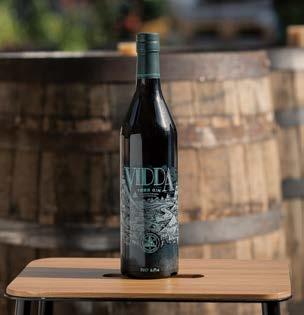

VODKA, GIN & AKEVITT
Aquavit, or Akevitt, is traditionally made in many of the Scandinavian countries, but Norwegian Akevitt made from potato spirit is traditionally aged in casks – usually casks that were previously used to mature fortified wines. OHD Cask-Aged Akevitt has aromas of sherbet and liquorice root with woody, tobacco and vanilla caramel notes.


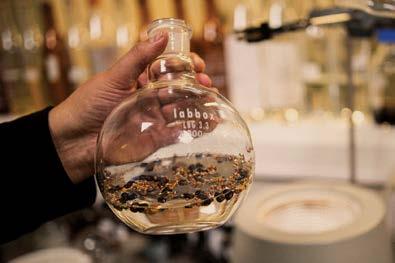
Norway has a long tradition of independent craft distilleries.
Before Norway's 1917 prohibition, there were over 10,000 registered distilleries, but a ban on liquor also meant the end of local hand-crafted distilleries. A state monopoly was introduced in 1927 and industrial liquor production dominated for the next 80 years.
Established in 2015, Oslo Handicraft Distillery was founded by three highly experienced members of the beverage industry: Marius Vestnes, Marcin Miller and Martin Krajewski, who Opimians will recognize as the man behind Château Séraphine, Clos Cantenac and Aristea Wines. The local team of four all have aquavit and spirits in their DNA.
Oslo Håndverksdestilleri stems from love for the Nordic outdoors, clean air, lakes, cuisine, design, and the country’s heritage of craft distilling. “We do follow the dogmas and rules of neo-Nordic cuisine. As we only use botanicals native to Norway we go into uncharted territory for spirits,” says Frederik Dahl, Sales and Market Manager. “A good example of the reflection of these flavours is the Vidda Tørr Gin, the first gin in the world made without citrus. All the botanicals in it have a long local tradition both as medicine and as ingredients in spirits,” mentions Matt Ensor, the winemaker-turned-distiller.

For those who want to try something different, the distillery’s Akevitt (aquavit) is made in the same manner as the gin, with carraway instead of juniper. Their potato-based vodka is also distilled with botanicals, and when Oslo developed it to drink, they mixed with tonic and in a martini.
Earlier this year, Oslo Håndverksdestilleri brought home the prestigious award of Grand Master from the Global Spirits Masters. Vidda Tørr Gin took home The Master medal in two categories. The Norwegian Wood Birch Vodka and OHD Akevitt each received a gold medal. “Winning the gin master title for a product like Vidda Tørr Gin, made with only botanicals native to Norway, in the biggest gin competition in spirits is amazing. It has given us a boost of confidence and interest in the product. When we later won a Master for our Akevitt, the first ever for an aquavit, we really had proof that we are doing something special and people are starting to notice it,” says Frederik. Who would have thought that this little distillery could rub shoulders with some of the world’s biggest players like Diageo and Pernod Ricard? Opimian is proud to make their gin, vodka and akevitt available to you.



FIND FRENCH WHISKEYS, CALVADOS & ARMAGNAC ONLINE, LOTS 2554 - 2556.
Château Bellevue is unusual in that it grows grapes, ferments and distills its wine, and matures its own Cognacs – most growers in the region supply grapes or base wine to the larger Cognac houses. The 108-hectare estate is bordered by six kilometres of stone walls and surrounds an 18th-century Château.
Cognac brandy can only be produced from grapes grown in the Charente and Charente-Maritime departments in southwest France. To be called “Cognac,” it also must be double distilled in a traditional copper swannecked alembic still and aged in Limousin oak casks for a minimum of two years, though many are matured a lot longer. As it matures in oak, alcohol evaporates into the atmosphere – known as the “angels’ share” – and the Cognac becomes more concentrated and complex in flavour – and smoother on the palate.
Folle Blanche, Montils,
$ 433.00 $ 866.00
The No. 1 was matured for over 50 years in Château Bellevue’s underground barrel cellar. Amber in colour, it has mellow caramel and orange fruit aromas with vanilla, toffee and oak. This complex and incredibly smooth Cognac was produced from Folle Blanche, Montils and Colombard grapes, all organically grown on the estate.
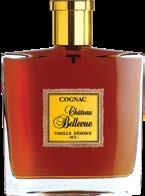
Elisabeth Cognac, owned by the Arrivé family, is based in Fins Bois, one of the five premium subregions of the Cognac Appellation.


ONE BOTTLE
VS, VSOP & XO

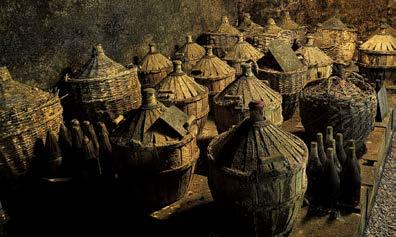
ELISABETH VS FINE COGNAC, AOC COGNAC FINS BOIS
VS, or Very Special, made from Colombard and Ugni Blanc was aged for three years. Pale in colour, it has nice fruity aromas. Quite light on the palate, it is soft with more smoky notes emerging.
ELISABETH VSOP FINE COGNAC, AOC
Colombard,
After six years in Limousin oak barrels, the Very Special Old Pale (VSOP) takes on a slightly deeper golden colour. The aromas are complemented with honeysuckle and almond notes with more woody oaky flavours.
ELISABETH XO FINE COGNAC, AOC
XO, or Extra Old, was matured for over ten years. It is amber in colour with a mahogany hue. Woody spice and smoke aromas lie over a fruit background. The palate is smoother with lots of vanilla, chocolate and caramel flavours.
The Bordeaux region in southwest France is probably the most famous wine-growing region producing some of the world’s finest wines. The region – trisected by the Garonne and Dordogne rivers, which combine to form the Gironde Estuary that flows into the Atlantic Ocean – naturally falls into three areas: the left bank, which lies south of the Garonne and Gironde, includes the Médoc; the right bank to the north of the Dordogne where SaintÉmilion and Pomerol are located; and the area which lies between the two and is known as Entre-Deux-Mers.
Entre-Deux-Mers lends its name to an Appellation for dry white wines produced from Sauvignon Blanc, Sémillon and Muscadelle. These same varieties planted on the left bank in the Graves Appellation make some of Bordeaux’s best dry white wines, often barrel fermented and with the potential for aging.


2542 SIEUR GAILLARD, AOC CRÉMANT DE BORDEAUX, BLANC BRUT
Sémillon, Muscadelle, Cabernet Franc
$ 30.00 $ 180.00
2021-2022, M8 D9
A Crémant makes a perfect aperitif. Sieur Gaillard is produced from three Bordeaux grape varieties and has nice white fruits, citrus lemon and lime and floral notes. It has a soft creamy texture with crisp finish.
2543
Ceviche with lime
CHÂTEAU HAUT MAGINET, AOC BORDEAUX, BLANC, VIGNOBLES JOLIVET, 2020
Sauvignon Blanc, Sémillon, Muscadelle

$ 25.00 $ 150.00
Château Haut Maginet 2020, a blend of 70% Sauvignon, 25% Sémillon and 5% Muscadelle, has subtle spring blossom aromas and white peach. It is round in structure with some citrus pith astringency on the finish. The addition of Muscadelle in Bordeaux white wines adds another dimension with its floral blossom scent.
2557

CHÂTEAU DE ROUQUETTE, CUVÉE DU PAVILLON, AOC BORDEAUX, BLANC, VIGNOBLES J. DARRIET, 2020
Sauvignon Blanc, Sémillon

2021-2022, M8 D9
Blossom, white peach 5°C
Citrus, [D] 13%
Gambas à la plancha
$ 23.00 $ 138.00
Cuvée du Pavillon 2020 is pale in colour with delicious lime, tropical fruits and flinty aromas with the same flavours shining through on the palate. This is a flavoursome easy drinking wine made from 70% Sauvignon with 30% Sémillon grapes. Produced by JeanChristophe Darriet from fruit from young vines at Château de Rouquette.
Vinaigrette leeks with walnuts and herbs
PETITE MARINE SAUVIGNON BLANC, AOC BORDEAUX, THE DARRIET FAMILY, 2020
Sauvignon Blanc

$ 24.00 $ 144.00
A pure and intense Sauvignon, it has gooseberry aromas with a subtle green leaf character in the background. It is fresh and zesty on the palate with lots of tropical fruit flavours and white peaches. Sauvignon juice was left to macerate with the grape skins for some hours to extract maximum aromas. After fermentation, the wine was matured on yeast lees for four months with regular “bâtonnage,” or stirring of the lees.
2559 CHÂTEAU DE ROUQUETTE, SAUVIGNON BLANC, AOC BORDEAUX, VIGNOBLES J. DARRIET, 2020
Sauvignon Blanc, Sémillon

A mineral wine with aromas of grapefruit, gun flint and lemon. It has a steely linear structure with sour lemon and lime acidity giving presence and persistence complemented by passion fruit flavours on the finish. 35- to 40-year-old Sauvignon Blanc and Sémillon vines are cultivated on gravelly soils with a south-southwest exposure. An early vintage, harvest started on August 20 to retain natural acidity and freshness.
2567
CHÂTEAU MARTINON, AOC ENTRE-DEUX-MERS, 2020
Sémillon, Sauvignon Blanc, Muscadelle

$ 27.00 $ 324.00
This is an intensely aromatic white with appealing aromas of passion fruit, grapefruit and green apples. Produced from a majority of Sémillon grapes, Château Martinon is at Gornac in the Entre-DeuxMers. The 2020 is a blend of 60% Sémillon, 30% Sauvignon Blanc, 10% Muscadelle.
Oysters on the half-shell with green apple mignonette


2545
Sauvignon Blanc, Sémillon

$ 26.00 $ 156.00
A supple white brimming with fresh lemon-citrus character and a touch of spring blossom. A blend of 85% Sauvignon and 15% Sémillon grown on limestone, it is a supple wine with medium body.
2544 LE CLOS DES PINS, AOC GRAVES, 2019
Sémillon, Sauvignon Blanc, Sauvignon Gris
$ 34.00 $ 204.00

Ripe tropical fruits, white peach and coconut aromas complement each other. This is a smooth broad wine which is round in structure. Sémillon makes up 50% of the blend, conferring this roundness, and is complemented by 35% Sauvignon Blanc and 15% Sauvignon Gris. Grapes were grown in the south of the Graves region on the left bank known for its premium whites. After pressing the grapes, the juice was immediately run into oak barrels for fermentation with 30% new oak.
CHÂTEAU LA FLEUR DES PINS, AOC GRAVES, SCE LAMOTHE, 2019
Sémillon, Sauvignon Blanc, Sauvignon Gris
$ 39.00 $ 234.00

White peach, nectarine blossom and mineral notes create a distinctive and appealing impression. This is an elegant wine which is also structured and powerful. On the palate flavours of cassis and peaches are complemented by a bitter white fruit character. From the same stable as Clos des Pins, it is a blend of 50% Sémillon, 13% Sauvignon Blanc, 15% Sauvignon Gris and a higher proportion of new oak was used. However, this is less apparent due to the concentrated nature of the fruit.
Crab cakes with peach-tarragon aioli

2580 PRINCE PIRATE ROUGE, CUVÉE TROIS SOEURS, VIN ROUGE DE FRANCE
Merlot, Cabernet Sauvignon $ 18.00 $ 216.00
A light- to medium-bodied red with wine gum, fruit flavours and a grippy finish. It is a blend of 91% Merlot and 9% Cabernet Sauvignon.
THIS CUVÉE IS NAMED FOR ALBERTA'S STUNNING THREE SISTERS MOUNTAINS. 2021-2023, M8 D9 Fruity, wine gums 16°C Grippy finish
Mediterranean grilled veg with herbs and garlic


Sauvignon Blanc
Nice limey gooseberry aromas lead to a light crisp palate. An easy drinking refreshing white.
Refreshingly light and crisp, [D]

Crisped Serrano ham with arugula and melon 2021-2023, M8 D9

2582 THE OPIMIAN SOCIETY'S CLARET, AOC BORDEAUX
Merlot, Cabernet Sauvignon, Cabernet Franc
A medium- to full-bodied claret with a grainy texture and some chewy tannins, it has earthy black fruit aromas and a bitterchocolate finish, produced from a blend of 65% Merlot, 30% Cabernet Sauvignon and 5% Cabernet Franc.
Earthy black fruits
Bitter chocolate, chewy
Beef and mushroom Stroganoff
FOR YOUR EVERYDAY DRINKING
BERNARD PERRIN CRÉMANT DE BOURGOGNE BRUT, AOP CRÉMANT DE BOURGOGNE
Chardonnay $ 33.00 $ 198.00

Produced from grapes grown in the south of the Beaujolais region – in an area known as Pierres Dorées around Ternand, Létra and Oingt – Crémant de Bourgogne has subtle aromas of peaches, white fruits with a touch of sour dough. It has a fine persistent mousse giving it a soft creamy texture. It is mellow with ripe white fruits and vanilla flavours enhanced by a fresh crisp finish.
White fruit, peaches, sour dough 6°C
Ripe white fruits, vanilla, [D]
Great on its own
START OR ADD TO YOUR BORDEAUX COLLECTION. They started making wine in Bordeaux in 60 BC. We didn’t start collecting those wines until the 1st century AD. Fast-foward to the 21st century; have you always wanted a well-balanced, wide-ranging Bordeaux Cellar but didn’t know where to start?
Here is your chance to build one in just a few clicks. This professionally curated Bordeaux “Instant Cellar” gives you wines from the entire region and in the various Bordeaux styles. It includes wines that are ready to drink and some that will cellar well.

THIS COLLECTION INCLUDES ONE CASE OF EACH OF THE FOLLOWING WINES
WHITE
Petite Marine Sauvignon Blanc, AOC Bordeaux, The Darriet Family, 2020 Case of 6, lot 2558, p28
SWEET WHITE
Château Fontebride, AOC Sauternes, SCE Château Haut-Bergeron, 2019 Case of 6, lot 2547, p35
ROSÉ
Haut Maginet, AOC Bordeaux Rosé, Vignobles Jolivet, 2020
Case of 6, lot 2548, p37
REDS
BORDEAUX
Château Les Tuileries, AOC Bordeaux, Rouge, 2018
Case of 6, lot 2584, p40
ENTRE-DEUX-MERS
Château de Rouquette, AOC Cadillac Côtes de Bordeaux, Vignobles J. Darriet, 2018
Case of 6, lot 2564, p41
LEFT BANK
Château Moutin, AOC Graves, Vignobles J. Darriet, 2015
Case of 6, lot 2566, p45
Madame de Beaucaillou, AOC HautMédoc, Famille Eugène Borie, 2018 Case of 6, lot 2553, p50
Le Petit Ducru de DucruBeaucaillou, AOC Saint-Julien, Famille Eugène Borie, 2018 Case of 3, lot 2572, p50
RIGHT BANK
Les Terrasses de Saint Christophe, AOC Saint-Emilion Grand Cru, 2018 Case of 3, lot 2578, p52
Château Grand Corbin-Despagne, AOC Saint-Émilion Grand Cru, 2018 Case of 3, lot 2579, p55
Vertical case: Château Cap St. George, AOC Saint-Georges Saint-Émilion, Jean-Philippe Janoueix, 2015 & 2016 Case of 6, lot 2576, p53
TOTAL FOR 11 CASES $ 2712











TO REALLY COMPLETE YOUR BORDEAUX
CELLAR, add the Château Séraphine, AOC Pomerol, 2019, (wood cases)
Case of 2, lot 2599, p59.

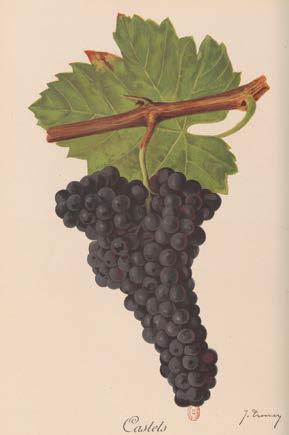


by Jacky Blisson MW
Bordeaux is a wine region steeped in history. The classification of Left Bank châteaux dates back to 1855. Traditional viticultural practices are passed down from one generation to the next. Families trace their estate ownership back hundreds of years.
It might seem surprising therefore that Bordeaux was the first French wine region to take official steps in the battle against climate change. In 2019, the wine producers of Bordeaux AOC and Bordeaux Supérieur AOC applied to the Institut national de l'origine et de la qualité* (INAO) to authorize the use of new grape varieties better equipped to face changing climate conditions. Their request was recently granted.
The expression of a specific blend of grape varieties grown on a specific vineyard site is what defines Bordeaux, giving its wines such a unique and sought-after appeal. Since the great replanting of vineyards after Phylloxera and the historic frosts of 1956, the distribution of these grape varieties has remained unchanged.
Cabernet Sauvignon is king on the gravel-rich soils of the Left Bank (the area to the west of the region’s major estuary, the Gironde, and its tributary, the Garonne). The Right Bank, to the east of the Gironde and the Dordogne tributary, is Merlot country.
The problem is that rising temperatures are changing growing season conditions, resulting in earlier bud break and harvest dates. Merlot, which accounts for some two-thirds of Bordeaux’s red vineyard acreage is an early ripening grape. The worry is that warmer summer weather will cause acidity in the grapes to plummet and sugars to rise long before the grape’s tannins have ripened.
The earlier the vine awakens from winter dormancy, the more susceptible its tender buds are to ravaging spring frosts. Climate change is also bringing more erratic weather patterns, which could mean wetter weather for Bordeaux, increasing the risk of rot.
To face this challenge, Bordeaux’s vine research facility, the Institut de la science de la vigne et du vin de Bordeaux (ISVV) planted an experimental plot in 2007 with 52 French and foreign varieties. The idea was to find later ripening varieties, with similar aromatics and structure to the current grapes, and lower susceptibility to fungal disease.
Six worthy candidates emerged from these trials, including red varieties: Marselan, Touriga Nacional, Castets, and Arinarnoa, and white grapes: Alvarinho (aka Albariño) and Liliorila. They are a mix of French Vitis vinifera crossings, long-forgotten French grapes, and Iberian varieties. Fans of classically styled Bordeaux will not find their beloved wines altered too dramatically, however. The new varieties can only cover up to 5% of an estate’s total surface area and make up 10% of blends.
* The INAO is the French organization charged with regulating French agricultural products with protected designations of origin.
Bordeaux has a long tradition of making sweet wines. The most famous is Château d’Yquem in the Sauternes Appellation, but there are other estates and Appellations such as Loupiac which in their day were equally reputed and which make great dessert wines. The same white grape varieties – namely Sauvignon Blanc, Sémillon and Muscadelle – as for dry wines are used, but the grapes are only picked after “noble rot” has developed becoming more concentrated and complex in flavour.

2560
NEW
CHÂTEAU DAUPHINÉ RONDILLON, CUVÉE D'EXCEPTION, AOC
LOUPIAC, VIGNOBLES J. DARRIET, 2009
Sémillon
$ 100.00 $ 300.00
A rich and developed dessert wine with great complexity. It is deep amber in colour with a bouquet of toffee, orange and roasted chestnuts. The concentrated palate has caramel and bitter-orange flavours with vanilla custard which stay in the mouth. It is produced from the oldest 100-year-old vines on the estate of Château Dauphiné-Rondillon from 100% Sémillon grapes. Individual botrytised grapes were harvested by hand and pressed into barrel. The fermentation stopped naturally due to the high concentration of sugar, and the naturally sweet wine was aged for 18 months in barrel. The Loupiac Appellation sits across the Garonne River facing Sauternes and makes similar style dessert wines.
2021-2026 M7 D9
Toffee, orange, chestnuts, smoke 6°C
Toffee, vanilla custard, caramelised oranges, [S] 13%
Hazelnut-praline chocolates



TAKE THIS CHANCE TO ENJOY THE BEST DESSERT WINES IN THE WORLD.
2547

CHÂTEAU FONTEBRIDE, AOC SAUTERNES, SCE CHÂTEAU HAUTBERGERON, 2019
Sémillon, Sauvignon Blanc, Muscadelle
$ 34.00 $ 204.00
Sauternes is famous for high-quality sweet dessert wines that are the result of its unique climate in late summer and fall which encourages the development of “noble rot.” Château Fontebride bouquet is a combination of fresh apples, cinnamon and smoke with some savoury mushroom character. On the palate, it is rich and sweet with good depth and youthful fruit. A bitter pithiness counterbalances the sweet mango flavours producing a dessert wine of great length and complexity which should cellar well. Fifty-year-old vines are cultivated in the commune of Bommes on gravelly soils over a clay subsoil. Successive passages through the vineyard to hand pick individual grapes affected by the “noble rot” were carried out.
2546

CHÂTEAU LA FLEUR DES PINS, AOC GRAVES SUPÉRIEURES, SCE LAMOTHE, 2018
Sémillon, Sauvignon Blanc, Muscadelle $ 49.00 $ 147.00
Bright yellow in colour with golden syrup, vanilla and savoury mushroom aromas, Château La Fleur des Pins Graves Supérieures was produced from vineyards in the commune of Pujols-sur-Ciron, adjacent to the Sauternes Appellation. The sweetness of the wine is offset by a firm acidity and flavours of bitter orange and clementine. It is well balanced with good depth and complexity. The 60-year-old vines sit on calcareous clay soils over rock. Grapes were harvested by hand with three successive pickings and the wine matured for ten months in used oak barrels.
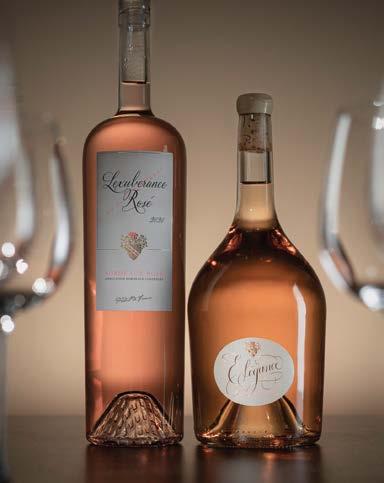
DISCOVER MORE CLOS CANTENAC WINES ON PAGE 56.



L'EXUBERANCE ROSÉ DU CLOS CANTENAC, AOC BORDEAUX ROSÉ, 2020
Bordeaux traditionally made deep-coloured rosé wines known as “Clairet” – the word dating to the 12th century is likely the origin of the term Claret used for red Bordeaux wines. In recent years, paler more fruity rosé wines are being produced.
L’Exuberance was the first ever rosé to be made in Saint-Émilion. Typically, 2020 is a perfect pale rose-petal pink colour. Redcurrant and lemon zest are complemented by a fresh green leaf and herbal note. A soft round wine with nice weight, it has red berry fruit, vanilla and savoury notes with a persistent pith finish.
Niçoise
DU CLOS CANTENAC, AOC BORDEAUX ROSÉ, 2020, (WOOD CASES)
Merlot
$ 98.00 $ 294.00

2561
$ 24.00 $ 144.00 2591
A new addition to the Clos Cantenac range, it is a sheer delight. Deliciously pale in colour, it has restrained aromas of redcurrants and citrus fruits with a touch of talc. Similar flavours show through on the palate. It is silky and fine in texture with crunchy fruits and a mineral acidity. A selection of Merlot grapes from around the property were harvested by hand on September 7, whole-bunch pressed, fermented and then aged in a concrete egg.
2021-2023, M8 D9
Talc, floral 6°C
Lemon, redcurrant, cranberry, [D] 12.5%
Terrine de Campagne
PETITE MARINE LE ROSÉ, AOC BORDEAUX, THE DARRIET FAMILY, 2020
Cabernet Sauvignon
2021-2022, M8 D9
Floral, rosehip 6°C
Redcurrant, lemon, [D] 12.5%
Grilled prawns with Sichuan pepper
2548
CHÂTEAU HAUT MAGINET, AOC BORDEAUX ROSÉ, VIGNOBLES JOLIVET, 2020
Cabernet Franc, Cabernet Sauvignon, Merlot
$ 25.00 $ 150.00
Pale in colour with a baby-pink hue, this wine is subtle in aroma with sherbet, raspberry and talc notes. It is smooth and round with a silky texture – and dangerously easy to drink. Produced from a majority of Cabernet Franc with 20% Cabernet Sauvignon and 20% Merlot, grapes were grown at Soussac in the Entre-Deux-Mers.
2021-2022, M8 D9
raspberry 5°C
Easy drinking, [D] 13%
Tartes

Medium to deep salmon-pink in colour, the Petite Marine Rosé has floral rosehip aromas. It is crisp and refreshing with crisp lemon and sour redcurrant flavours that persist.


The majority of wines made in Bordeaux are red: Cabernet Sauvignon, Merlot, Cabernet Franc and sometimes a bit of Petit Verdot or Malbec. Each location is influenced by its proximity to the Atlantic, the Dordogne and the Garonne rivers and its soils making it more or less suitable for growing the different grape varieties giving rise to a total of 57 Appellations across the region.
While the most prestigious wines for cellaring command high prices, there are a lot of well-priced wines produced for everyday drinking. Many of these are Appellation Bordeaux or Bordeaux Supérieur, wines often coming from the Entre-Deux-Mers area.
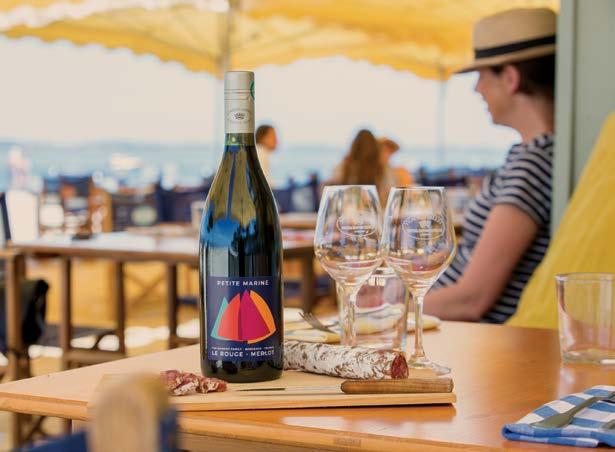

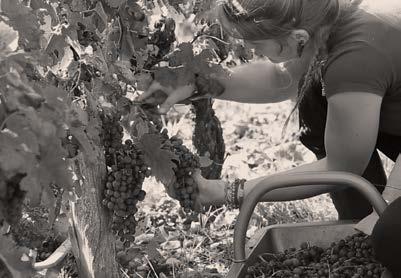
DE ROUQUETTE, CUVÉE DU PAVILLON, AOC BORDEAUX, VIGNOBLES J. DARRIET, 2020
A fruity wine with aromas of fresh crushed strawberries and strawberry jam. It is soft, light to medium bodied with sour red fruit flavours and a powdery texture.

Produced from 100% Merlot, Cuvée du Pavillon 2020 has aromas of plums, black wine gums and savoury nuts. It is medium to full bodied with a plump mid palate finishing with nice blackcurrant and plum flavours.

A spicy wine with incense and floral aromas, it was made from Merlot grown on 20-year-old vines on clay soils. It is medium bodied with plummy fruits, bitter cherry flavours and some grip on the finish.
2550
CHÂTEAU DU PIN, AOC BORDEAUX, 2019
Merlot, Cabernet Sauvignon, Cabernet Franc
$ 24.00 $ 144.00
A medium-bodied wine with aromas of blackcurrant and coffee, it has ripe black fruit flavours, a succulent mid palate and some grip on the finish. Château du Pin, in the far east of the Entre-Deux-Mers region, is farmed by Jean-Marie Constans and his wife Claudette who makes the wines. This is a blend of 50% Merlot 25% Cabernet Sauvignon 25% Cabernet Franc grown on clay and chalk soils.


2551
CHÂTEAU HAUT MAGINET, AOC BORDEAUX, VIGNOBLES JOLIVET, 2020 Merlot, Cabernet Sauvignon, Cabernet Franc

Pascale Jolivet farms his family estate in the village of Soussac. Produced from 60% Merlot, 20% Cabernet Sauvignon, and 20% Cabernet Franc, 2020 is flavoursome with aromas of fresh strawberries and cooked red fruits. It is supple with blackberry flavours and a firm chewy finish.
2584
CHÂTEAU LES TUILERIES, AOC BORDEAUX, ROUGE, 2018
Merlot, Cabernet Sauvignon
26.00 $ 156.00

A medium- to full-bodied wine, it is structured with some firm tannins and cellaring potential. This was an immediate hit for me with the quality of the limestone terroir expressed in its tightly-knit linear structure. The 2018 is deep plum in colour with aromas of red apples and cherries.
Merlot, Cabernet Sauvignon, Petit Verdot

Dark fruits with floral notes lead to a smooth palate with a marked acidity and sour cherry flavours. This Bordeaux Supérieur property north of Pomerol has just three hectares in the commune of Saint-Denis-de-Pile. Predominantly Merlot with 20% Cabernet Sauvignon and 10% Petit Verdot, it is light in tannin with a long bitter cherry finish.

Oaky aromas of coconut and vanilla with blackcurrant lead to a wine with a pure linear structure. Eric Meynaud has 25 hectares of vines on southfacing slopes around Massugas in the Entre-Deux-Mers. Medium bodied overall, it has a relatively light mid palate with sour blackcurrant flavours and a grippy chewy finish.
CHÂTEAU DE ROUQUETTE, AOC CADILLAC CÔTES DE BORDEAUX, VIGNOBLES J. DARRIET, 2018
Merlot, Cabernet Sauvignon $ 35.00 $ 210.00

A mellow wine with fresh redcurrants, blackberries and cooked fruits with vanilla aromas. It is smooth and elegant on the palate with a fine-layered texture leading to some graininess on the finish. It is harmoniously balanced with dark fruit and smoke flavours. Drinking nicely now, it has the potential for some cellaring. Vines are cultivated on a gravel slope facing south close to the town of Cadillac. It was matured for 24 months in one-year-old oak barrels.
tenderloin with


The Bordeaux landscape is sprinkled with famous wineries. Every style and era is represented, from the Medieval era to contemporary times with renowned architects renovating the old properties. The most common châteaux are simple rectangular 19th century south-facing houses, known as "Girondines." Here are a few of Opimian's favourite châteaux!
1. Ch Maillard: Mazères (lot 2568, p45)
2. Ch Moutin: Portets (lot 2566, p45)
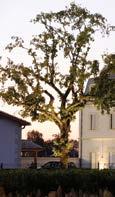

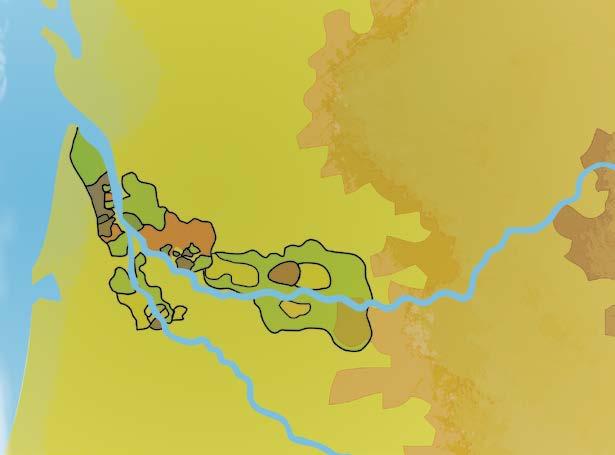
3. Ch d'Escurac: Civrac-en-Médoc (lot 2552, p47)
4. Ch Méric: Jau-Dignac-et-Loirac (lot 2587, p47)
5. Ch Camino Salva: Cussac-Fort-Médoc (lot 2569, p48)
6. Ch Ducru Beaucaillou: Saint-Julien-Beychevelle (lots 2553, 2572, p50)
7. Ch du Retout: Cussac-Fort-Médoc (lot 2570, p49)
8. Ch La Tour Carnet: Saint-Laurent-Médoc (lot 2571, p48)
9. Ch Grand-Puy Ducasse: Pauillac (lot 2573, p51)
10. Ch Pichon Barron: Pauillac (lot 2574, p51)
11. Ch La Confession: Saint-Émilion (lot 2575, p54)
12. Ch Cap St. George: Saint Georges Saint Emilion (lot 2576, p53)
13. Ch La Pointe: Libourne (lot 2577, p55)
14. Ch Tour St Christophe: Saint-Christophe-des-Bardes (lot 2578, p52)
15. Ch Grand Corbin-Despagne: Saint-Emilion (lot 2579, p55)
16. Clos Cantenac: Saint-Emilion (lots 2591-92, 2595, 2588, pp36, 56)
17. Ch Séraphine: Libourne (lots 2598, 2599, p58)
Right Bank/Entre-Deux-Mers
18. Ch Dauphiné-Rondillon: Loupiac (lot 2560, p35)
19. Ch Mayne-Graves: Saint-Denis-de-Pile (lot 2585, p41)
20. Ch Haut-Maginet: Soussac (lots 2543, 2548, 2551, pp27, 37, 40)
21. Ch Martinon: Gornac (lot 2567, p28)


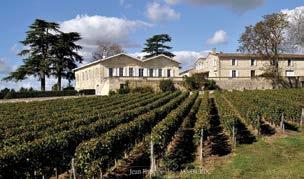
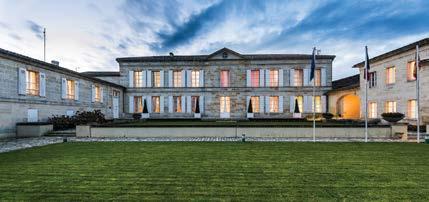



The Left Bank is the area south of the Gironde estuary and Garonne River. It includes the Médoc and well-known Appellations such as Pauillac and Margaux extending north-westwards from the city of Bordeaux up towards the Atlantic coast. Heading south from Bordeaux down to Langon, the Left Bank includes the Graves region, so named after its gravelly soils (rather than any preponderance of churchyards) which tends to produce lighter reds than the Médoc. A higher proportion of Cabernet Sauvignon tends to be found in Left Bank red wines as the gravel soils and climate allow the lateripening variety to fully mature, producing wines which are structured and tannic. The even later ripening Petit Verdot may also play a role in blends, alongside Merlot, Cabernet Franc and a small amount of Malbec.
The Médoc is home to famous Appellations and Châteaux which were classified in 1855 into five quality levels based on the prices that punters were prepared to pay for their wines. Despite some Château wines falling in and out of favour, this classification is still used as a guide. At the top of the pyramid are five “First Classed” growths whose quality commands such high prices that the wines are out of the reach for many. In recent years, Châteaux Pichon Baron and DucruBeaucaillou have become known as “super” Seconds nipping at the heels of the first growths in terms of quality, and they can command prices higher than other Second Classed Growths. Beneath the Classed Growths are several hundred Cru Bourgeois Châteaux which are classified on a regular basis.
In order for the Classed Growths to produce the very best wine possible, no holds are barred and they have the resources and know-how to do so! Even so, not every plot is the same and may vary from one year to the next, and nor every barrel will be great. This is why many of the top estates produce second wines (and some even third and fourth wines). These wines are made in the same way as those that go into the Grand Vin but, for whatever reason, just don’t make the final cut. Good second wines offer an “aperçu” of the Grand vin, are generally ready for earlier drinking and can offer great value for money.


Subtle red berry aromas are quite restrained leading to a supple mediumbodied palate. It is round and fleshy in structure with good weight and flavours of bitter cherry and incense. Produced from Merlot from 56-year-old plots around Portets on sandy and fine gravel soils known as Pyrénées Gravel Mindel II.
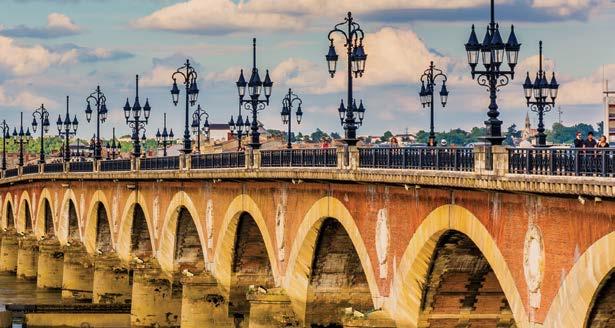
CHÂTEAU MOUTIN, AOC GRAVES, VIGNOBLES J. DARRIET, 2015
Merlot, Cabernet Sauvignon
$ 37.00 $ 222.00
Produced in the great 2015 vintage, this wine is really showing nicely now with mellow coconut, red berries and cherry aromas. It is medium bodied with a layered powdery texture and nice red cherry flavours. An elegant, classy wine showing some nice development whilst remaining youthful. Jean-Christophe Darriet tends three hectares at Portets with 80% planted to Merlot and 20% to Cabernet Sauvignon. Vines are 50 years old and a strict grape selection is carried out. It was matured for 24 months in oak, with 50% new and 50% one-year-old barrels.

2568 CHÂTEAU MAILLARD, AOC GRAVES, 2020
Merlot, Cabernet Sauvignon, Malbec $ 24.00 $ 288.00
Located in the far south of the Graves Appellation at Mazères, Château Maillard has 58 hectares planted mainly to Merlot with 25% Cabernet Sauvignon and 5% Malbec. The 2020 is dense in colour with dark fruits, plums and a touch of green leaf. It is medium bodied and structured with nice layers of flavour with some fresh cassis and fine-grained tannins.

Wine cellar (noun): a room for storing wines, also: a stock of wines
As we continue to get to know you, the Members, the discussion inevitably leads to "what should I order?". Despite every wine in the cellar having been vetted and selected for its quality and value, each of us certainly can't order them all (don't let us stop you). Our first question back to you is "what do you like?" and the second is "what do you have in your Cellar now?"
Your answers will lead us to the array of styles you see here. Choose from your favourite categories and add one that you'd like to get to know. That way, you'll be broadening your knowledge and appreciation of everything that the wine world has to offer.
Vodka, Gin & Aquavit
OHD MIXED CASE, LOT 2539, P23



Pairs with anything, celebrations, romance
SIEUR GAILLARD, AOC CRÉMANT DE BORDEAUX, BLANC BRUT, LOT 2542, P27

MEDIUM WHITE
Poultry, mild cheeses, pork
PETITE MARINE SAUVIGNON BLANC, AOC BORDEAUX, THE DARRIET FAMILY, 2020, LOT 2558, P28
Dessert, rich foods like foie gras
CHÂTEAU FONTEBRIDE, AOC SAUTERNES, SCE CHÂTEAU HAUT-BERGERON, 2019, LOT 2547, P35
Most appetizers, sipping on its own, the back deck
CHÂTEAU PIQUE-SÈGUE, AOC BERGERAC, ROSÉ, 2020, LOT 2535, P19



LIGHT RED
Many pastas, pork, poultry, sipping on its own
CHÂTEAU MAYNE-GRAVES, AOC BORDEAUX SUPÉRIEUR, 2018, LOT 2585, P41

MEDIUM RED
Versatile; many meats without heavy sauces, casseroles
DOMAINE DIT BARRON, AOP BROUILLY, GILLES AUJOGUES, 2020, LOT 2520, P9
Heavy stews, many game meats, lamb, strong cheeses, even dessert
CHÂTEAU LA CONFESSION, AOC STÉMILION GRAND CRU, JEAN-PHILIPPE JANOUEIX, 2018, LOT 2575, P54


2552
LA CHAPELLE D'ESCURAC, AOC MÉDOC, 2017
Cabernet Sauvignon, Merlot, Petit Verdot
$ 31.00 $ 186.00
A light- to medium-bodied wine which is nicely mature and perfectly ready for drinking over the next few years. It has spicy aromas with incense, cigar box and pot pourri which complement its savoury meaty character. The mid palate is quite light as the tannins build in the mouth to give grip. This is the second wine of Château d’Escurac and is named after the pretty 11th-century chapel on the estate. The vineyards at Civrac-en-Médoc in the far north of the Medoc, close to the Atlantic Ocean and the Gironde estuary, lie on a 17-metre high gravelly mound (that’s high for the Médoc!) over a clay subsoil. La Chapelle has a higher content of Cabernet Sauvignon in the blend with 60% Cabernet Sauvignon, 37% Merlot and 3% Petit Verdot.

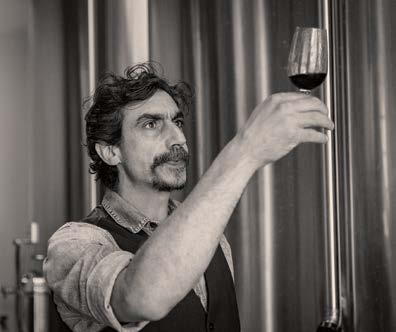
2587 CHÂTEAU MÉRIC, AOC MÉDOC, CRU BOURGEOIS, 2018
Merlot, Cabernet Sauvignon, Petit Verdot
$ 46.00 $ 276.00
A nicely developed wine with mellow aromas, it has lots of appeal. Fresh ginger, blackcurrant, incense with a hint of forest floor all show on the nose. It is quite light on the palate, linear in structure with lingering savoury and cedar flavours and a grippy finish. Produced from a blend of 52% Cabernet Sauvignon, 34% Merlot and 14% Petit Verdot grown on sandy gravel


Sauvignon, Merlot, Petit Verdot
A spicy wine with tobacco, black cherries and sweet dark fruits. It is medium bodied with a grainy texture, plummy flavours and a grippy finish. The 2016 is a blend of 56% Cabernet Sauvignon, 39% Merlot, 5% Petit Verdot from the southern end of the Appellation. Half was matured in barrel for nine months, the balance in tank.


2571
LES PENSÉES DE LA TOUR CARNET, AOC HAUT-MÉDOC, BERNARD MAGREZ, 2015
Sauvignon, Merlot
65.00 $ 195.00
An elegant and youthful wine brimming with redcurrants, mulberries, dark fruits, treacle and vanilla. It is medium bodied with a fine powdery texture and layers of flavour. The second wine of Château La Tour Carnet, a 4e Cru Classé whose origins date to the 12th century making it the oldest fortified Château in the Médoc. The estate is one of four Grands Crus Classé owned by Bernard Magrez. The vineyards at Saint-Laurent Médoc lie inland from the estuary behind Saint-Julien facing south by southwest on gravel over clay and limestone.
CHÂTEAU DU RETOUT, AOC HAUT-MÉDOC, CRU BOURGEOIS, 2015
Cabernet Sauvignon, Merlot, Petit Verdot
An intense spicy and oaky character with pencil lead and menthol dominating the nose. More fruit comes through on the palate. It has a succulent mid palate with ripe fruit and spicy incense flavours. It is concentrated and rich and not yet at its peak. It is a blend of 71% Cabernet Sauvignon, 25% Merlot, 4% Petit Verdot and was matured for a year in oak barrels with one third new.
2021-2028, M7 D8
Pencil lead, menthol 18°C
Spicy, ripe fruit, cedar 13.5%
Grilled hanger steak with salsa verde
CHÂTEAU DU RETOUT, AOC HAUT-MÉDOC, CRU BOURGEOIS, 2016
Cabernet Sauvignon, Merlot, Petit Verdot
Less obvious oak character, the 2016 has floral violet and peony aromas with spicy ginger and some vegetal notes. The palate displays juicy fruits although less opulent than the 2015. It is tight in structure with a firm finish possibly due to a slightly higher proportion of Petit Verdot and will benefit from some more time in bottle. It is a blend of 71% Cabernet Sauvignon, 23% Merlot, 6% Petit Verdot.
2022-2028 M6 D7
peony, ginger
Lamb chops with chile tamarind

Château du Retout, situated at Cussac-Fort-Médoc, is midway between Margaux and Pauillac. It has approximately 35 hectares of vineyards planted on a gravelly outcrop with the estate managed and wines made by Hélène Soual Kopp with her husband Frédéric. The vines have an average age of 30 years, although the oldest were planted in the 1950s when the Kopp family purchased the estate and merged it with Château Camino Salva and Château Moulina.
THREE BOTTLES EACH 2015 & 2016



MADAME DE BEAUCAILLOU, AOC HAUT-MÉDOC, FAMILLE EUGÈNE BORIE, 2018
Merlot, Cabernet Sauvignon, Cabernet Franc, Petit Verdot
A new wine made by Château DucruBeaucaillou, itself a Second Classed Growth and Saint-Julien’s most iconic estate, this wine screams elegance and breeding. It has toast and roasted hazelnuts, cedar and blackcurrant aromas. It is refined and intense with cherry and fresh red fruit flavours. The oak is less apparent on the palate which is smooth and medium bodied. Named as a tribute to Madame Eugène Borie, it was made from vines in the Haut- Médoc, which the family acquired through her marriage. The first vintage 2018 is a blend of 39% Merlot, 37% Cabernet Sauvignon, 21% Cabernet Franc and 3% Petit Verdot. It was matured for 12 months in barrel with 20% new oak.

LE PETIT DUCRU DE DUCRUBEAUCAILLOU, AOC SAINTJULIEN, FAMILLE EUGÈNE BORIE, 2018
Merlot, Cabernet Sauvignon
105.00 $ 315.00

Another of Château Ducru-Beaucaillou’s wines, Le Petit Ducru is made from a selection of the estate’s Saint-Julien vineyards – generally plots that are a little away from the estuary close to those of Châteaux Talbot and Lagrange. A vibrant wine with cherries, red apples and vanilla aromas. It has great depth on the nose and palate which is layered with a silky texture. This is a refined wine with both power and elegance finishing with flavours of blackcurrants, plums spicy vanilla and chocolate. It sits comfortably in the Ducru stable and truly is a younger brother to La Croix and the much higher priced Grand Vin Château Ducru-Beaucaillou.
Muscovy magret with ragout of mushrooms
PRELUDE A GRAND-PUY DUCASSE, AOC PAUILLAC, 2017
Merlot, Cabernet Sauvignon
$ 87.00 $ 261.00


2574 LES GRIFFONS DE PICHON BARON, AOC PAUILLAC, 2017
Cabernet Sauvignon, Merlot
A powerful wine with great breeding, it has aromas of coffee, toast, cedar, violets and blackcurrants. It is medium bodied with a pure linear structure and great depth with lots of ripe dark fruits, smoke and a long bitter chocolate finish. Made by the team at Château Pichon Baron, a Second Classed Growth in 1855, which is today a “super Second” nipping at the heels of the first growths. Les Griffons 2017 is a blend of 52% Cabernet Sauvignon and 48% Merlot, grown on gravelly parcels close to the estuary and perfect to achieve maturity in Cabernet Sauvignon. It was matured for 18 months in barrel with 60% new oak and 40% second-use barrels.
The 2017 is deliciously expressive with musk, spices, cedar and dark fruits and was matured 12 months in barrel with 30% new oak. It is a supple medium-bodied wine with a silky texture and layers of lingering sour cherry and balsamic flavours. A delight already, it is not yet at its zenith and will repay keeping. This is the second wine of fifth-growth Château Grand-Puy Ducasse. The estate’s vineyards are in three large parcels within the Pauillac Appellation with Prelude A made from grapes from younger vines. It is a blend of 70% Merlot and 30% Cabernet Sauvignon.
Roasted strip loin with Madeira jus
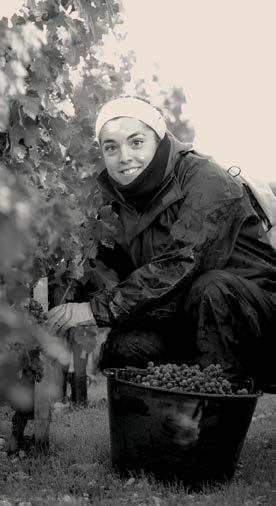
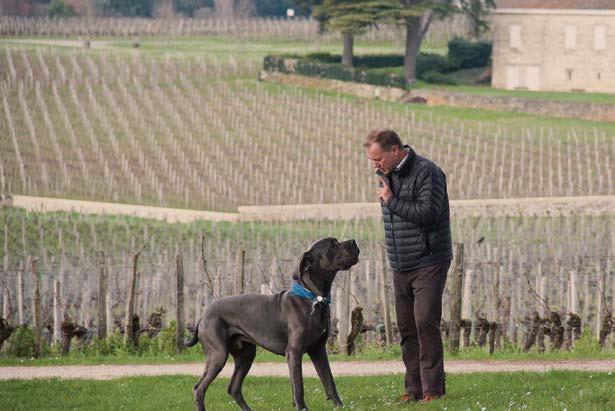
The Right Bank is the area to the north of the Dordogne River with famous Appellations such as Pomerol and Saint-Émilion. Further away from the moderating influence of the Ocean, this is the region where Merlot dominates, often blended with Cabernet Franc. Merlot produces bigger, plumper wines with mid-palate weight and a less muscular tannin structure. Often wine drinkers have a preference for Left or Right Bank due to this stylistic difference.
LES TERRASSES DE SAINT CHRISTOPHE, AOC SAINT-ÉMILION GRAND CRU, 2018 Merlot, Cabernet Franc
2021-2026, M6 D8 Coconut, red fruits, dried flowers, figs 18°C Dark fruits, blackcurrant, smoke 14.5% Roast pheasant with chanterelles


2576 CHÂTEAU CAP ST. GEORGE VERTICAL CASE $ 70.00
Jean-Philippe Janoueix comes from a Bordeaux wine dynasty starting in 1867 with Jean Janoueix. Fast forward several generations to Jean-Philippe who has built up his own portfolio of wine estates on the Right Bank. Château Cap Saint George, located in one of Saint-Émilion’s satellite Appellations, Saint-Georges-Saint-Émilion, was purchased by Jean-Philippe Janoueix in 2014. There are four Saint-Émilion satellites named after four villages which lie north of the town of Saint-Émilion. Saint-Georges is the smallest. The estate has 17 hectares of vines planted on limestone clay soils in two plots facing directly south and south-southwest.
BOTTLES EACH 2015 & 2016


Aromas of red fruits combine with oaky coconut character, dried flowers, figs and a touch of leather creating lots of interest. Succulent dark fruits emerge on the palate which is dense and grainy in texture with a smoky blackcurrant finish. This is the second wine of Château Tour Saint Christophe situated in the east of the Saint-Émilion Appellation. It has narrow terraced vines overlooking the Saint Laurent Valley. The estate has been reviving the terraces and old drystone walls built in the 18th century. Les Terrasses is made from younger vines, predominantly Merlot with 10% Cabernet Franc. It was matured in new and old barrels for 15 months.
CHÂTEAU CAP ST. GEORGE, AOC SAINTGEORGES SAINT-ÉMILION, JEAN-PHILIPPE JANOUEIX, 2015
Merlot, Cabernet Franc
Lots of spicy oak in the 2015 bouquet with stewed fruit, red fruit and treacle behind. It has quite a light mid palate given the 89% Merlot with Cabernet adding some grip on the finish. After fermentation, the wine was put into barrels for malolactic fermentation using 50% new and 50% one-year-old oak barrels and was left on lees until the following spring.
CHÂTEAU CAP ST. GEORGE, AOC SAINTGEORGES SAINT-ÉMILION, JEAN-PHILIPPE JANOUEIX, 2016
Merlot, Cabernet Franc
Mellow dark fruits, the oak is more integrated and less obvious despite the same combination of 50% new and 50% one-year-old barrels. It is a mediumbodied wine and supple with good midpalate weight which should become more expressive with time.
Treacle, spices, stewed fruits
dates
Boeuf en croûte (Beef Wellington)
Confit de canard with Robuchon potatoes and red cabbage
ONE BOTTLE EACH 2015, 2016 & 2018

CHÂTEAU LA CONFESSION, AOC STÉMILION GRAND CRU, JEAN-PHILIPPE
JANOUEIX, 2015
Merlot, Cabernet Franc

An elegant wine with great depth of flavour. The bouquet is a savoury fruit combination with red cherries, earthy fresh mushrooms, some oak with vanilla and savoury meaty notes. It is quite light in structure with a fine texture and persistent flavours of bitter cherries, plums and menthol.
CHÂTEAU LA CONFESSION, AOC STÉMILION GRAND CRU, JEAN-PHILIPPE
JANOUEIX, 2016
Merlot, Cabernet Franc

Treacle, raisins, dark and baked fruits combine with dusty oak and testify to the warm drought summer of 2016. Flavours of blackcurrant emerge with some aeration, so I would recommend decanting a little ahead of drinking. On the palate, balsamic notes with a firm acidity lift the wine and lead to a grainy finish with flavours of cedar and menthol.
Château La Confession is a small estate with seven hectares that lies just outside the town of Saint-Émilion on the main road towards Pomerol and Libourne. The vineyard now has an average age of 50 years. Jean-Philippe makes the wines in much the same way as at Cap Saint Georges.
de
CHÂTEAU LA CONFESSION, AOC STÉMILION GRAND CRU, JEAN-PHILIPPE
JANOUEIX, 2018
Merlot, Cabernet Franc

A full-bodied wine with cassis aromas and a rich concentrated palate, this was my favourite of the three. It is succulent and structured with flavours of sour black fruits, blackberries and vanilla with good depth. It needs a bit more time in bottle to reveal its full potential but should mature nicely.
2579 CHÂTEAU GRAND CORBINDESPAGNE, AOC SAINT-ÉMILION GRAND CRU, 2018
Merlot, Cabernet Franc, Cabernet Sauvignon
$ 119.00 $ 357.00

Deep and vibrant in colour, this youthfulness carries over onto the taste with aromas of blackcurrant and vanilla. It is medium to full bodied with rich and concentrated sweet dark fruit flavours. The nice mid-palate fruit are complemented by a firm grainy texture and a smoky, bitter cherry finish. The estate, located in the north of the Appellation close to Pomerol, has been in the Despagne family since 1812. It consists of 29 hectares planted on clay sand over iron deposits and ancient sands over clay. It is organically farmed. The 2018 is a blend of 75% Merlot, 24% Cabernet Franc, 1% Cabernet Sauvignon and was matured in barrels with 50% new, 40% one year old and 10% two-year-old.
Merlot, Cabernet Franc $ 81.00
A deliciously enjoyable wine now, it has a brick colour with a bouquet of spicy vanilla, ginger and earthy fruits. It has a soft rich palate with succulent plump fruit with the 91% Merlot blend. Sweet red fruit flavours lead to bitter almonds and cherries on the finish. Located in the southwest of the Pomerol Appellation, Château La Pointe has 23 hectares planted on a range of soils with small gravel and pebble soils from the Isle River terrace, clayey-gravel and sandy soils over clay or gravel sub-soils. Ballade de la Pointe is the second wine produced for earlier drinking and is showing really nice development.


Clos Cantenac has six hectares of vines in four main parcels planted on deep gravels and sand and clay over limestone. Owned by Martin Krawjeski for the last 15 years, his daughter Charlotte is now in charge of the wines: she makes intensely concentrated, rich and flavoursome wines.
PRODUCER FOR THIS CELLAR
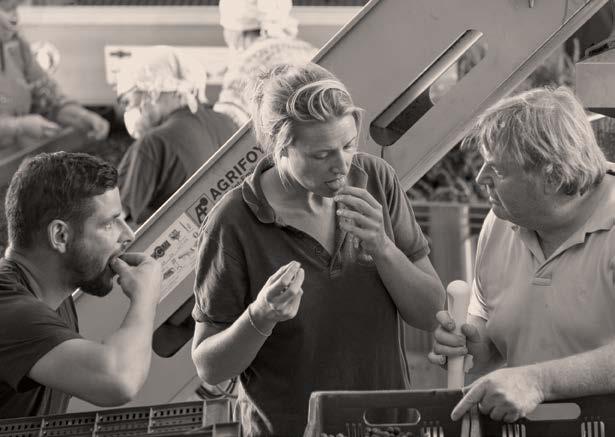



CANTENAC, AOC SAINT-ÉMILION GRAND CRU,

PETIT CANTENAC, AOC SAINT-ÉMILION GRAND CRU, 2019
Merlot, Cabernet Franc, Cabernet Sauvignon
Wood, toast, and graphite notes waft over dark fruits in the background with a touch of violet. This wine simply unfurls on the palate revealing more fruit, blueberries, blackberries, cherries and cream. It is rich and concentrated brimming with ripe fruits and coffee and is medium to full bodied. Produced from 100% Merlot, it retains, however, a mineral streak adding vitality and depth and should mature majestically.
2019 Petit Cantenac is intensely coloured with rich aromas of dark fruits, blueberry, black cherry,and ginger and musk combined. It is round in structure with a plump mid palate and good weight. Fresh dark fruit, liquorice and plum flavours are followed by some grippy tannins – the wine will benefit from a few years in bottle. It is a blend of 85% Merlot, 10% Cabernet Franc and 5% Cabernet Sauvignon.



with cherry-kumquat
By Martin Krajewski, proprietor, Clos Cantenac and Château Séraphine
The Pomerol appellation and its boundaries were only officially recognized in 1928 but the uniqueness of the divergent terroirs and soils here have remained unchanged for millions of years.

The highest point in Pomerol is known as the 'Hill of Petrus' but the terroir of the appellation is a complex blend of clay, gravel, sand, crasse de fer and iron oxide, although it is the clay laden soils that produce the richest, densest, most opulent and flamboyant wines of sensuous and rich character.
Clay is a product of degraded limestone, which explains why you often find limestone and clay located in the same terroir. This takes place because limestone is high in pH and calcium, which eventually breaks down due to time and erosion. Clay soils can also contain a high level of CEC, (Cation Exchange Capacity) which is important as it allows the soils to help bring more nutrients to the vines.
This unique clay-dominated terroir, along with the predominant plantings of Merlot vines, make it almost always the first major Bordeaux region to harvest, but there are several types of clay in the Pomerol soils and the most famous is the blue clay.
This blue, smectite clay is estimated to be close to 40 million years old and is incredibly dense making it almost impossible for the vines to penetrate. However, in wet vintages it acts as a sponge with an incredible ability to expand and retain water, although this must be balanced by effective drainage systems and gravels, which is exactly what naturally occurs at the best vineyards with blue clay.
As a result, the water molecules are able to penetrate the inter layer molecular spaces of the clay, so when the dry summer months arrive, the vines are still able to feed on the much needed moisture.
Therefore, it will come as no great surprise to hear just how absolutely delighted we were when Xavier Chone, our Conseil du Terroir (vineyard consultant) was actually able to confirm his already strong suspicion of the existence of the blue clay in our new vineyards at Château Séraphine. Xavier's analysis involved excavating a series of threemetre deep trenches, which revealed this famous, but illusive sought-after commodity. It was obviously a discovery of great joy and it brought enormous excitement, as it is an indicator that even in most severe drought years, we could still expect to harvest high quality fruit. This is a winemaker's dream. When such crucial elements successfully combine, the result is one of great wines that are sensuous and hedonistic, offering complex perfumes of truffles, chocolate, flowers, dark cherries, plums and exotic spices, that not only entice and beguile, but also reward careful cellaring and patience.
In late 2016, Martin Krajewski purchased two parcels of old vines in Pomerol in the south west of the appellation. He re-named the vineyard after his polish grandmother Seraphina, built a new winery and with his daughter Charlotte prepared for their first vintage. So started the story of Chateau Séraphine. The 2.23-hectare vineyard is split between a 1-hectare parcel at Plince, located close to the winery on a welldraining slope of sandy topsoil over clay and deep gravels, part of which was replanted in 2017. The second plot at Mazeyres is itself formed of two parts, the first where old Merlot vines are planted on deep gravel soils, the other with the blue clay beneath sandy and gravel was replanted.

Red cherries, cherry menthol and mineral notes lead to an elegant and refined palate. A medium bodied wine with quite a light mid palate, it is smooth with supple tannins and lingering cherry menthol flavours. It was matured in oak barrels and a clay amphora. The second wine from Château Séraphine is produced mainly from the young plantation.
Savoury herbs and pine aromas lay over a background of red cherries, strawberry and vanilla cream. The supple smooth palate oozes charm with cooked patisserie flavours, ripe red fruits, dark chocolate and vanilla. This is an elegant wine, medium bodied with a grainy texture finishing on lingering notes of red apples, butterscotch and spices.
RARE FINDS TO ENHANCE YOUR CELLAR
RARE FINDS TO ENHANCE YOUR CELLAR

Please visit Opimian.ca for your province's pricing on these wines.

Produced in Lorraine, the GralletDupic family were distillers of the local Mirabelle spirit for more than 150 years before becoming the first distillery in France to make malt whiskies. All are double distilled and aged in casks made from local oak forests as well as casks from Kentucky, Sherry, Burgundy and southwest France. 2555 SINGLE MALT WHISKY CASE
ONE BOTTLE EACH ORIGINE, RARE & FUMÉ
G.ROZELIEURES, SINGLE MALT WHISKY, ORIGINE COLLECTION
Golden yellow with fruity aromas, honey and hint of smoke and earth. Quite light on the palate with a lingering smoky finish, it was matured in sherry oak casks.

G.ROZELIEURES, SINGLE MALT WHISKY, RARE COLLECTION Whisky 40%
Deeper in colour, the Rare Collection has mellow aromas with dried raisins and fruits. This is smooth and rich with caramel and chocolate flavours. It was matured in a combination of casks from Sherry, Cognac and Sauternes.


G.ROZELIEURES, SINGLE MALT WHISKY, FUMÉ COLLECTION Whisky
Golden yellow, smoky but not overly so, it is quite fiery with earth and chocolate flavours.
Domaine de Saoubis, in the Bas-Armagnac, produces a range of fine Armagnacs matured in 400-litre new oak casks and older barrels. All grapes are farmed biodynamically and Demeter certified.

SAPHIR JAUNE, BAS-ARMAGNAC, AOC ARMAGNAC, VSOP, DOMAINE DE SAOUBIS, 2012
Armagnac 42%
Bright golden yellow in colour, the Saphir Jaune 2012 has grapey and spicy vanilla aromas. It has sweet raisin flavours on the palate and is supple and smooth. It is 100% Folle Blanche matured for six years.
2556 DOMAINE DE SAUVIS ARMAGNAC CASE - JEWELRY COLLECTION
$ WEB $ WEB

SAUVIS AMBRE ROYALE, BAS-ARMAGNAC, AOC ARMAGNAC, X.O., 2009
2554
MARQUIS DE SAINT-LOUP CALVADOS, SÉLECTION, AOC CALVADOS Calvados
A soft, smooth Calvados with nice appley aromas, cooked apples, cidery with some floral notes and a long finish. Produced from the Domfront region renowned for its fruitiness and appeal for early drinking.
Deeper golden colour, the Ambre Royals has lots of woody and spicy aromas with vanilla. Aged for more than ten years in cask, it is supple and mellow with lingering flavours of rum and raisin.

ONE BOTTLE EACH SAPHIR, AMBRE & TOPAZE

SAUVIS TOPAZE IMPÉRIALE, BASARMAGNAC, AOC ARMAGNAC, HORS D'AGE, 2006
Similar in colour to the Ambre, Topaze Impériale has smoky and flint aromas. It is mellow with woody flavours, caramel and sweet vanilla.

C280: Burgundy Pinot Noir, Australia & New Zealand
Opens November 10, 2020
Last day to order: December 14, 2020
Mail form by: December 1, 2020
Expected release: Spring 2021
C281: Tuscany & South Africa
Opens December 15, 2020
Last day to order: January 18, 2021
Mail form by: January 4, 2021
Expected release: Early Summer 2021
C282: Alsace, Argentina & Chile
Opens January 19, 2021
Last day to order: February 22, 2021
Mail form by: February 8, 2021
Expected release: Summer 2021
C283: Rhône, Champagne & Burgundy White Wines
Opens February 23, 2021
Last day to order: March 29, 2021
Mail form by: March 15, 2021
Expected release: Late Summer 2021
C284: Spain
Opens March 30, 2021
Last day to order: May 3, 2021
Mail form by: April 19, 2021
Expected release: Early Fall 2021
C285: Bordeaux, Bergerac & Beaujolais
Opens May 4, 2021
Last day to order: June 7, 2021
Mail form by: May 21, 2021
Expected release: Fall 2021
C286: Piemonte, Veneto, Italy & Germany
Opens June 8, 2021
Last day to order: July 12, 2021
Mail form by: June 28, 2021
Expected release: Early Winter 2022
C287: Provence, Loire, Corsica & Languedoc-Roussillon
Opens July 13, 2021
Last day to order: August 16, 2021
Mail form by: July 30, 2021
Expected release: Early Winter 2022
C288: Portugal, California, Oregon & Austria
Opens August 17, 2021
Last day to order: September 20, 2021
Mail form by: September 3, 2021
Expected release: Winter 2022
Fall Online Offering: September 21 - October 11, 2021
CWEB21 Online Offering: October 12 - November 8, 2021
If you have any questions or want to order, contact us: MemberService@opimian.ca or 1 800 361-9421
- White - Rosé - Sparkling - Port/Dessert - Spirit Bottle size
Number of bottles in case Aroma Taste
Serving temperature
Percent of alcohol1 Ideal with Evolution Drink this year Will develop, drink within 2 years Meant for cellaring
- Medium - Great
- Medium - Heavy
Let yourself be inspired by Opimian’s Master of Wine, Jane Masters MW, and her detailed descriptions included in the Cellar Offering. Our custom chart on the reverse side features a list of symbols to help guide your selection.
Still unsure which wines to order? Contact us!
There are four ways to order. The last day to order for each Cellar Offering can be found listed on the reverse. No orders will be processed after this time.
Full name
Member no.
Payment Methods
l Cheque
l Use of wine credits
l Use credit card on file. Please go to your dashboard at Opimian.ca to update your credit card on file or contact Member Service.
How can we reach you if we have questions on your order?
Telephone:
MasterCard, American Express), wine credits or cheque payable to Opimian.
• Prices include all applicable federal and provincial markups and taxes.
• A valid membership card is required to order.
• Bottle prices are for reference only. In the case of any price discrepancy between printed materials and the website, the price published on the website prevails.
• All orders are by the case, with no minimum required.
Notes, as required by the law in the Province of Quebec
The wines featured on this Cellar Offering are still at the producers’ wineries when you order them, so it is normal that the process takes a bit of time and effort on our side.
Release dates are dependent upon actual arrival dates, distance from port of entry to liquor board and processing time required by each liquor board. For this Cellar Offering, the expected release date is listed on the reverse.
Once the wine arrives at your local liquor store or distribution centre, you will receive a Pick-up Notice with the specified date (the Release Date) and your pick-up location.
• A member ordering from this Cellar Offering requests that Opimian acts as the member’s agent in ordering the wines from the Société des Alcools du Québec (SAQ) and requests that Opimian remits the funds enclosed (minus any administration fees) to the SAQ to pay for the wines ordered.
• The prices as shown are the estimated costs to be charged by the SAQ plus an administration fee and consolidation charges.
Notes, as required by the law in the Province of Alberta
• All purchase transactions are completed pursuant to the laws in the Province of Alberta and are between you as the customer and Rocky Mountain Wine, Spirits & Beer (“Rocky Mountain”), an independent third party of Opimian Society (“Opimian”). All charges will appear on your credit card statement as Rocky Mountain.
• You hereby acknowledge and agree that your dealings with Rocky Mountain which are not related to an Opimian purchase, including payment and all other terms, conditions, representations and warranties related to such transaction, whether implied by law or by expressed agreement between you and Rocky Mountain, are solely between you and Rocky Mountain and not Opimian. You hereby acknowledge that Opimian is not responsible or liable for any loss or damage of any kind incurred as a result of, or in connection with, or a resulting transaction, and you hereby release and waive any claims you may have against Opimian in connection thereof.
A CONNOISSEUR’S DREAM. Exclusive to this program, Founders Choice wines are not available elsewhere in the Cellar Offering and won’t be for another five years. Dedicated to the spirit of our Founders, this program presents only the finest wines. From our producers’ cellars to yours, this is an opportunity to experience another level of quality. This case of one premium wine is curated with the potential to age.
Included in your six bottle case, you will find tasting notes and a special message from the producer to treasure. The Founders Choice producer for this Cellar is Bordeaux's Clos Cantenac.
